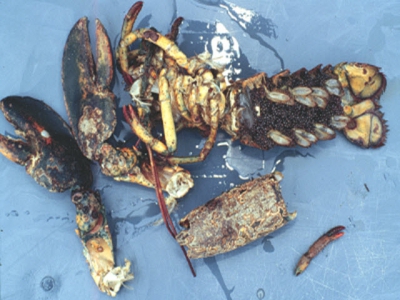Lobster shell disease moving towards Maine

A shell disease that has run rampant through the US New England’s lobster industry for years has moved northward to the lobster-filled grounds off the Maine coast, reports Web Pro News.
The number of lobsters suffering from shell disease is still small in Maine, with approximately 3 out of every 1,000 lobsters last year suffering with the disease.
Even though the number is low, scientists are concerned because the prevalence has grown fivefold from 2010 to 2012.
The disease does not cause harm to humans and was first noticed in southern New England in the 1990s. About one in every three or four lobsters that have been caught in waters off of southern Massachusetts and Rhode Island over the past few years have been diseased.
The state lobster biologist with the Department of Marin Resources,Carl Wilson, says that people “should be concerned, but not alarmed by the numbers”.
What started out as little black spots appearing on lobster’s shells, has now turned into a disease that is rotting the shells completely. Even though the disease does not ruin the lobster’s meat, it can make the shell look so repulsive that they can not be served as a whole.
What is causing this disease? Kathy Castro, a fisheries biologist at the University of Rhode Island Fisheries Center says: “Shell disease could be linked to a number of pressures such as rising water temperatures, pollution and low oxygen levels in the water. But in terms of our perspective of Gulf of Maine shell disease, we don’t see it as something to get particularly concerned about. The rates are pretty low. We don’t see a pattern.”
In 2008 there was one diseased lobster for every 2,000. In 2012, that number rose to six in every 2,000, and began alarming the fishermen. The lobster industry is valued at more than $400 million to fishermen and other coastal communities in Maine and New England.
“From talking to fisherman from Massachusetts on up, it seems like each year it’s moving its way north a little bit,” said South Bristol lobsterman Arnold Gamage Jr. “If we go all day long and I see a few that have shell disease, I think to myself, ‘That’s a lot,'” Gamage said. “And I suppose it is a lot compared to none. But it’s still a very small number; it’s way less than 1 percent.”
The state lobster biologist with the Department of Marin Resources,Carl Wilson, says that people “should be concerned, but not alarmed by the numbers”. Some people may look only at the percentage increase and could get worried and say, “Oh, my god, that’s a huge increase,”Wilson said. “But it’s not, considering all the sampling we have and all the caveats of our sampling design,” he said. “But it’s something we are watching.”
Related news
 Regional authorities in China move to close 40,000 shrimp ponds
Regional authorities in China move to close 40,000 shrimp ponds Authorities in Jiangsu Province’s recently issued a notice to “quit shrimp or close down” to the owners of up to 40,000 polytunnel-style covered shrimp ponds.
 Do current shrimp practices favor EMS?
Do current shrimp practices favor EMS? Early mortality syndrome (EMS), also known as acute hepatopancreatic necrosis, typically affects shrimp postlarvae within 20 to 30 days after stocking
 New ‘killer’ shrimp virus threat in China as production drops
New ‘killer’ shrimp virus threat in China as production drops The issues with acute hepatopancreatic necrosis disease (AHPND) -- more commonly known as early mortality syndrome, or EMS -- and other diseases